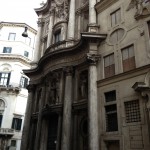Metropolitan Museum of Art San Carlo Alle Quattro Fontane Interior

San Carlo alle Quattro Fontane (1638-1641, too called San Carlino) by Francesco Borromini
Where in the world, in which metropolis…tin you find on the same street, within a cake of each other, two of the near beautiful buildings in the world? Not only that, each represents the creative person's all-time example, designed free-rein (and gratuitous of committee)—by the two Baroque architects who transformed a city?
Only in Rome.
It was Borromini's rational geometry and Bernini'south emotional theatricality that set them apart and every bit rivals. Funnily though, the onetime'south church building appears whimsical and irregular and appeals straight to the visitor'due south innate actual senses and instincts; whereas that of the latter is proper and orderly merely feasts the eye, invoking psychological reactions, even as both aim to venerate God. One favors space, the other decoration.
Borromini's San Carlo alle Quattro Fontane (1638-1641, as well called San Carlino) is like shooting fish in a barrel to miss. It is at the junction of two busy streets at an birdbrained angle on a hill, on Via del Quirinale (not far from the Spanish Steps). Walking southward on Via delle Quattro Fontane, looking up to your right across the intersection, yous can see the wavy façade of the church pulsing towards you. You can't assist but smiling. Information technology's happy and welcoming, whimsical, even a bit mischievous. The dancing curves remind one of the ancient grotesque decoration in Domus Aurea ( Nero's Villa, 64 Advertising), which had been revived during the Renaissance.
Undulating façades are believed to be original to Borromini (1599-1667), not seen before in Baroque or Renaissance compages. The highly original church building looks like an invitation, a curtain ready to part for the actions to come up inside. And it just draws you in.
The interior of the church, with an unusual oval-shaped nave that is mirrored in the dome above continues the play of curves from the outside. The intricately concave and convex entablature separates the lower wall from the upper office and surrounds the church, which is painted white, with minimum decoration. The whole infinite is awash with light from the windows at the base of the dome and the lantern. And, instead of existence painted, the dome is filled with angular geometric shapes and crosses in white, adding to the illumination and giving structure and pinnacle to the space; looking up is inevitable in this very intimate space. Stepping exterior to the cloister on the right, one notices that the rectangular courtyard is non the least bit evidently: the four corners are cut at an oblique, with actress columns and creating a subtle octagon. This little particular (and those in the dome) recalls the site: the outside corner of the church being occupied by 1 of the four fountains at the streets' intersection.
Go along downhill a block is the again, modest Sant'Adrea al Quirinale (1658-1670) by Gian Lorenzo Bernini (1599-1680), Borromimi'due south contemporary and arch rival. Hither the dissimilarity in manner hits you immediately: a direct, severe classical façade is softened by a minor circular portico, which is properly echoed in the round outline of the main body of the church building behind and the curved one-half walls on either side. But the primary space within is a slight oval—and very daringly with the curt axis connecting the visitor's approach to the high chantry. The overwhelming decorations and rich colors practice not continue the eyes from looking at the altar which is illuminated past the hidden lantern above.
Bernini's theatre is here in full swing: sculptures appear to fly and interact, culminating in the dramatic high altar with its rays of sculpted sunburst glorifying the ascendance of St Andrew to God in heaven, with angels in droves.
Bernini is said to have considered this church his highest accomplishment and often returned to visit in his quondam age, a virtual aristocrat surrounded by riches. As for Borromini, his subsequently commissions never attained the perfection of his small San Carlino and committed suicide in 1667 at the age of 68, probably a result of his lifelong suffering from low.
Bernini had trained every bit a sculptor and much of his piece of work on St Peter's in the Vatican was initially with the help of Borromini, who trained from an early age as a stonemason and was self educated. But ultimately, it was the businesslike Bernini who truly understood (and frequently exploited) the emotional Borromini, proverb:
…simply Borromini understood this profession, but that he was never content and that he wanted to hollow out i thing inside some other, and another inside that without ever getting to the end… a painter or a sculptor in their architecture have as their guides to proportion the homo body, but Borromini must accept based his on chimeras.
One could say that while Bernini's interior choreography illustrates activity and motion, Borromini's sculpted space elicits them in its visitors, guiding them on a journey of self discovery.
Please follow and like us:
riverafiresom1957.blogspot.com
Source: http://eyes-wide.com/roman-pearls-baroque-beauties-borromini-vs-bernini/
0 Response to "Metropolitan Museum of Art San Carlo Alle Quattro Fontane Interior"
Post a Comment